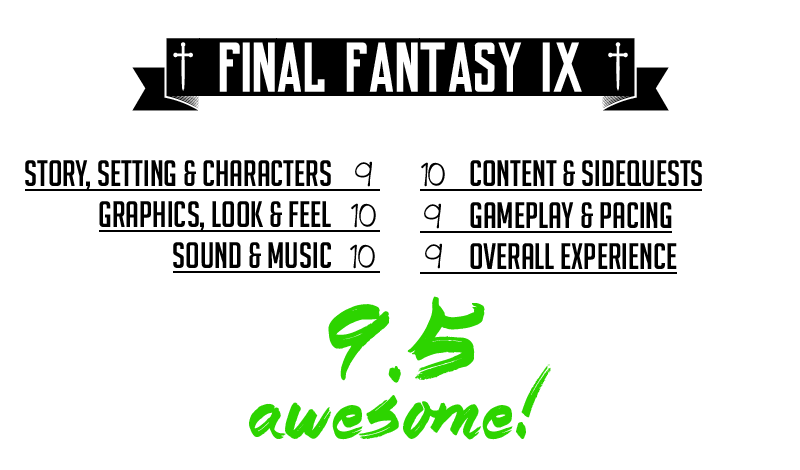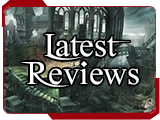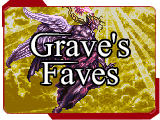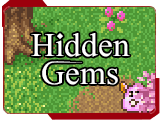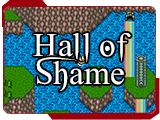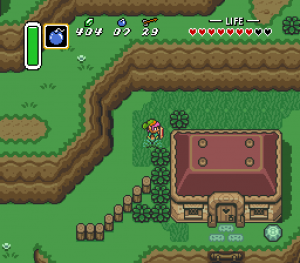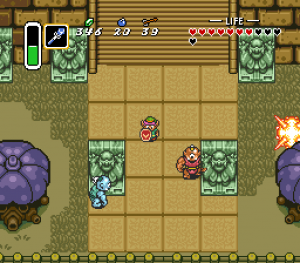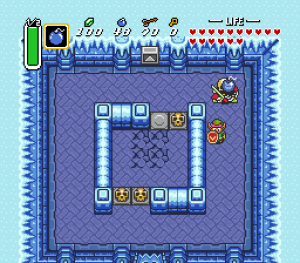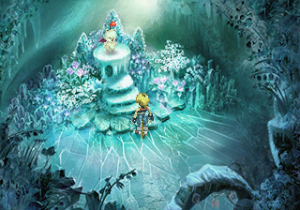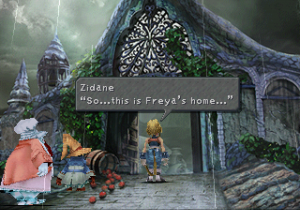Grave's RPG Reviews
Game Boy Advance · Nintendo 2DS/3DS · PC · PlayStation · PlayStation 3
PlayStation 4 · PlayStation Portable · PlayStation Vita · RPG Maker · SNES · Switch · Wii
WiiU · Xbox 360 · Xbox One
The Legend of Zelda: A Link to the Past
When you think of action RPGs, it’s almost impossible not to think of the Legend of Zelda series, the well-known and beloved franchise which started its humble roots on the NES, and quickly branched out into a series of games spanning almost every Nintendo console to date. While none could agree on exactly which is the objectively best game of the series, A Link to the Past — the third in the series, and the only to feature on the SNES — is undeniably at least one of the top five.
Essential Information
This Review: SNES (1992)
Near-Identical Versions: Game Boy Advance (2002), Nintendo Wii (2007), Nintendo WiiU (2013), New Nintendo 3DS (2016)
Game Length: 15-17 hours
Critic Rating: 94% aggregateThe aggregate critic rating is based on independent review scores from several other websites.
Grave’s Thoughts
In what will be a completely unsurprising story for anyone who has played another game of the series, the green-clad and mute protagonist Link embarks on an epic quest to defeat the evil lord Ganondorf and rescue the fair princess Zelda, while restoring the corrupted Dark World to its former glory as the Golden Land, the resting place of the almighty artifact known as the Triforce.
That’s it, that’s the entire story.
What the Zelda games lack in complex plot and character development, they make up for in sheer fun. The game’s two worlds — the kingdom of Hyrule in the Light World, and the sinister Dark World — have a variety of environments to explore, foes to defeat, and a wealth of hidden areas and secrets to discover. The dozen or so dungeons generally have their own unique theme and feel — and yes, of course there’s an ice dungeon — and as well as having a variety of different enemies that must be defeated in various ways, the dungeons also feature simple yet satisfying puzzles that must be solved with the plethora of magical items and equipment Link will gather on his adventures.
Outside of the dungeons is a fairly large overworld to explore — two, in fact, with the Dark World being a corrupted and evil reflection of Hyrule — with no small amount of secrets, ranging from hidden caves filled with treasure or magical items, to talking trees, gambling mini-games, and much more. As Link acquires more powerful equipment to bypass obstacles such as heavy rocks or broken bridges, the worlds slowly open up and allow for more exploration and discovery. The game is surprisingly non-linear, with three early dungeons in the Light World and seven in the Dark World able to be completed in any order, though it won’t be possible to unlock every hidden secret without gathering all of Link’s magical items.
It’s hard not to find something to love in the adorable, cartoonish visuals of this game. The charming graphics help make the world feel alive, especially with little background touches such as the animated flowers with bouncing petals. A Link to the Past feels like being inside a cartoon, in the best kind of way — the varied landscapes and dungeons are colourful and exciting, the enemies and townsfolk are detailed and cute, the animations and special effects are absolutely top-notch. Whether you’re trudging through a swamp or exploring a mystical forest, there’s something new and interesting to see around every corner of this varied, technicolour land.
The game features an excellent soundtrack which, while hardly up to Final Fantasy standards, is memorable, upbeat and perfectly fitting for the theme of the game. If the rousing overworld theme isn’t enough to spur you on to adventure then I don’t know what will, while the Dark World theme is suitably moody while still being upbeat and exciting. The sound effects in the game are nothing short of perfect — at least, as close as the SNES can get to perfection. Combat and magic feel satisfying, bombs sound suitably beefy, Link’s adorable cries and whimpers match the cartoonish feel of the game perfectly, and the mechanical clink of the hookshot always sounds great. There’s nothing quite as satisfying as the whoosh-tink sound as Link swings his sword around after defeating a boss.
Gameplay-wise, imagine everything an action RPG should be — easy to learn, satisfying and responsive controls, a variety of fun weapons and equipment, varied and unique boss battles, and a plethora of different enemies to battle. A Link to the Past is all of these things and more, a paragon of 2D action RPGs, with gameplay that can be described as close to perfect.
A Link to the Past has a strong sense of freedom, exploration and wonder, and many of the most satisfying moments of the game come from discovering a clever use for items or abilities to access a new area, or to solve a vexing puzzle. There’s always something new around every corner to explore and discover, and while the gameplay is well-balanced enough that it can be completed by anyone with reasonable gaming skill, finding every last hidden secret without the help of a guide is an impressive feat indeed.
In conclusion, this lively, colourful game has aged surprisingly well and is a well-crafted, enjoyable experience for gamers of all ages. Despite its paper-thin story, the masterfully-crafted gameplay and quirky, unique game world make up for its shortcomings in spades.
The cartoonish style, bright colours and upbeat soundtrack make this experience a cheerful, light-hearted adventure to find a legendary sword, rescue princesses, defeat an evil villain, and save the world.
Because sometimes, you just need to relax and not worry about the heavy themes of more serious games. Sometimes, you just want to feel like a little kid again.
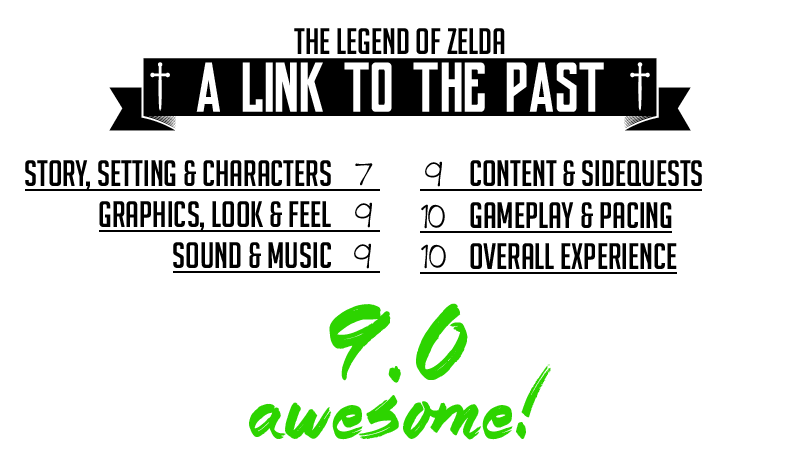
Grave's RPG Reviews
Game Boy Advance · Nintendo 2DS/3DS · PC · PlayStation · PlayStation 3
PlayStation 4 · PlayStation Portable · PlayStation Vita · RPG Maker · SNES · Switch · Wii
WiiU · Xbox 360 · Xbox One
Final Fantasy IX
The Final Fantasy series — as the name might imply — began as a purely fantasy setting with a diverse cast of warriors, mages, and a host of other RPG fantasy archetypes. While VI dabbled in steampunk-esque magic-technology and its sequels VII and VIII both delved entirely into futuristic sci-fi/fantasy worlds, Final Fantasy IX was a return to form for Square, a throwback to the traditional swords-and-sorcery themes featured so heavily in the earlier games in the series, along with a resurgence of the classic archetypes such as Black Mage and Thief.
Fortunately for Square, the gambit was a huge success — released near the end of what many would consider to be the golden age of JRPGs (the era spanning the SNES and PlayStation 1), IX paints a stunningly gorgeous world full of colour, life and character. Loaded with enough nostalgia to appeal to fans of the older games in the series, the game is still easily strong enough to stand on its own merits even for one who has never experienced a Final Fantasy game before.
Essential Information
This Review: PlayStation (2000)
Near-Identical Versions: PlayStation 3 (2010), PlayStation Portable (2010), PlayStation Vita (2012), PC (2016), PlayStation 4 (2017)
Game Length: 40-50 hours
Critic Rating: 92% aggregateThe aggregate critic rating is based on independent review scores from several other websites.
Grave’s Thoughts
The tale begins with Zidane, a rogueish lad with a monkey tail and a quick wit, conspiring with his fellow gang of thieves — masquerading as a theater troupe, Tantalus — to kidnap the Princess of Alexandria and hold her to ransom. Meanwhile, a young and rather timid black mage named Vivi is distraught to discover that his ticket to see Tantalus’ play is a fake, and tries to find another way to sneak in to watch. These and a number of other characters meet in unlikely ways and band together to begin a quest of political intrigue and betrayal, escalating rather predictably into a struggle for the fate of the world itself.
While the plot isn’t terribly dense, the writing and character development are fantastic, there’s plenty of good humour to break up the serious moments, and the world is charming enough to quickly draw the player in. It very firmly places both feet in familiar ground and sticks fairly unabashedly to the old-school Final Fantasy formula — almost certainly an intentional decision, as the game is clearly a celebration of the series’ earlier history.
The cast of characters fit into the archetypes of many well-known Final Fantasy jobs from previous games, though their well-written characters shine through and give them all distinct and unique personalities. Each character is unique and engaging, and much of the game’s humour derives from the constant conflicts between Zidane and his companions.
A significant step up from its predecessors, the visuals in Final Fantasy IX are nothing short of superb, and some of the best graphics you’ll ever see on the original PlayStation. The pre-rendered backgrounds are richly-detailed and varied, aided by animated elements both in the foreground and background, while the character models are expressive and thoroughly charming. The world itself is beautiful and varied, from the Qu swamps to the desert town of Cleyra, there’s always something new to see and explore, and while the game world certainly doesn’t break any ground in terms of originality, it fits firmly into the classic Final Fantasy style. Despite the low native resolution of the PlayStation, the game is a visual treat from start to finish, backed up by a perfectly capable (if fairly unremarkable) user interface.
The soundtrack is where this game truly shines the brightest — in this reviewer’s humble opinion, it’s some of Nobuo Uematsu’s finest work. The rich and detailed world is complemented perfectly by an unforgettable soundtrack — some of the most stand-out tracks include Rose of May, You’re Not Alone and Jesters of the Moon, though these are but a handful of the incredible music this game has to offer. It’s easy to get lost in the charm and beauty of the game’s world, with the combination of lush visuals and such a top-notch soundtrack.
With a few minor niggles here and there, the gameplay is absolutely the high quality one would expect from PS1-era Square, with a traditional yet highly refined battle system, mini-games and side-content as bizarre as catching frogs in a swamp or answering trivia questions for prizes, and a refreshingly unique system of gaining new character skills by drawing out the latent abilities of equipped items. Most of the game is spent exploring the overworld, cities and dungeons, and solving minor puzzles to progress through area, though the game allows just enough of a sense of freedom to not feel entirely too linear. A few elements help to mix things up and keep the experience fresh, such as a hunting festival where you must compete to score the most kills within a time limit, or the collectible card game Tetra Master.
Those who have played Final Fantasy VIII may remember Triple Triad, a minigame involving collecting and battling with decks of cards. It was everything a good minigame should be — easy to learn, difficult to master, and generally enjoyable to play. Tetra Master, Square’s second attempt at an in-game card minigame, is none of these things — some of the game mechanics are intentionally obfuscated and seem to make no sense, and what should be an enjoyable minigame (which, in one section, is mandatory to progress the story) is an exercise in frustration. This is a minor niggle and the entire card game can be largely ignored, however.
Despite some small flaws, Final Fantasy IX still stands out as one of the finest games in the series, a thoroughly enjoyable and heavily story-driven adventure which will charm all but the most hard-hearted. While often overshadowed by its predecessors, IX is a classic and unforgettable game every JRPG fan should try, a richly-detailed world full of life and character, with secrets and surprises hidden around every corner. I’d even consider this an excellent contender for the first Final Fantasy game a player should experience, if they’re completely new to the series.
If you love the bright, colourful, cheerful worlds of the earlier Final Fantasy games, then you’d be doing yourself a disservice by not trying IX, a throwback that manages to stand on its own two feet as an unforgettable experience, in addition to being jam-packed full of nostalgia.
